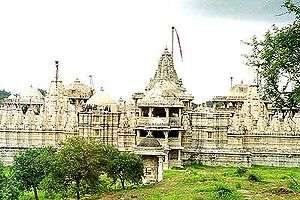Porwad
| Part of a series on |
| Jainism |
|---|
 |
|
Jain Prayers |
|
Practice |
|
Major figures |
|
Major Sects |
|
Festivals |
|
Pilgrimages |
| Jainism portal |

Porwal (also known as Porvad and Porwal) are mainly Hindus or Jain community that originated in southern Rajasthan, India. Ancient inscriptions written in Sanskrit refer to the community as Pragvata.
They originated from a region east of ancient Shrimal.[1] Today numerically they rank behind the Oswal and Shrimal Jains from the same region. However, in antiquity, they appear to have been more numerous and among the wealthiest.
Many Jain temples were built by the Porwals, including:
- Ranakpur Jain temple of Dharna Shah, completed in 1441 CE [2]
- Luna Vasahi (1231 CE) of Vastupal and Tejpal at Mount Abu
- The Adinath temple at Shatrunjaya by Javad Shah in 961 AD, which was subsequently renovated several times.
The Porwad community became divided into several regional communities including the Sorathia (in Saurashtra), the Kapol, the Jangad Porwad, and the Porwad found in the Nimad region of Madhya Pradesh. Some of the groups became a part of the Oswal or Navnat communities.
Both Jain traditions, Svetambara and Digambar, are represented among different sections of the Porwad community. The historian H. L. Jain has suggested that Krisha, the patron of Muni Srichandra, a Digambara monk, belonged to the same Ninanvaya clan as Vimala who built the Vimala Vasahi temple at Abu.[3] Thus the one branch of the family followed Swetamabra tradition, while other followed Digambara tradition. This suggests the harmonious coexistence to the two Jain traditions in that region.
In the 16th century, Pushti Marga was founded by Vallabha, a Brahmin scholar from Telangana, who proposed that in the modern age, it is too hard to follow the Jnana & Karma Margs. He proposed Pushti Marga (Raag, Bhog and Shringar used in the seva of Shri Krishna) as an alternative. A section of the Porwads has converted to Pushtimarga. Those who have converted to the Pushtimarg are known as Meshri (derived from Maheshwari)[4] or Vania.
Gotras
There are total 24 Gotras in Porwal Community.
See also
References
- ↑ Anthropological Survey of India (2004). K. S. Singh, ed. People of India: Maharashtra. Mumbai, India: Popular Prakashan. p. 1738. ISBN 978-81-7991-102-0.
- ↑ "Dharna Shah and Construction of the Temple". Herenow4u.net. Retrieved 2012-04-22.
- ↑ Muni Srichandra's Kahakosu, Prakrit Text Society, 1969, H.L. Jain editor
- ↑ The Eighteenth-Century Social Order in Surat: A Reply and an Excursus on the Riots of 1788 and 1795, by Lakshmi Subramanian, Modern Asian Studies, 1991, p. 321-365
| ||||||||||||||||||||||||||||||||||||||||||||||||||||||||||||||||||||||